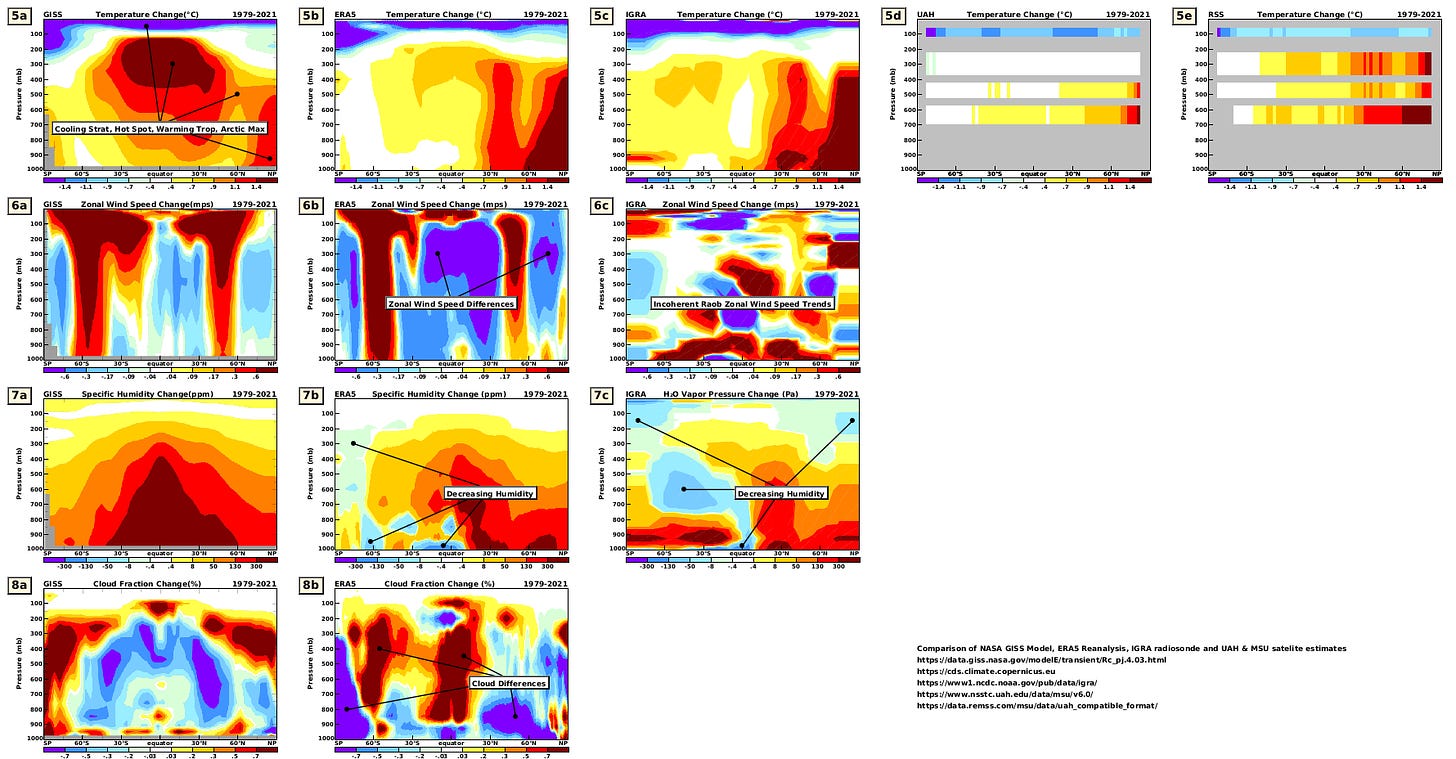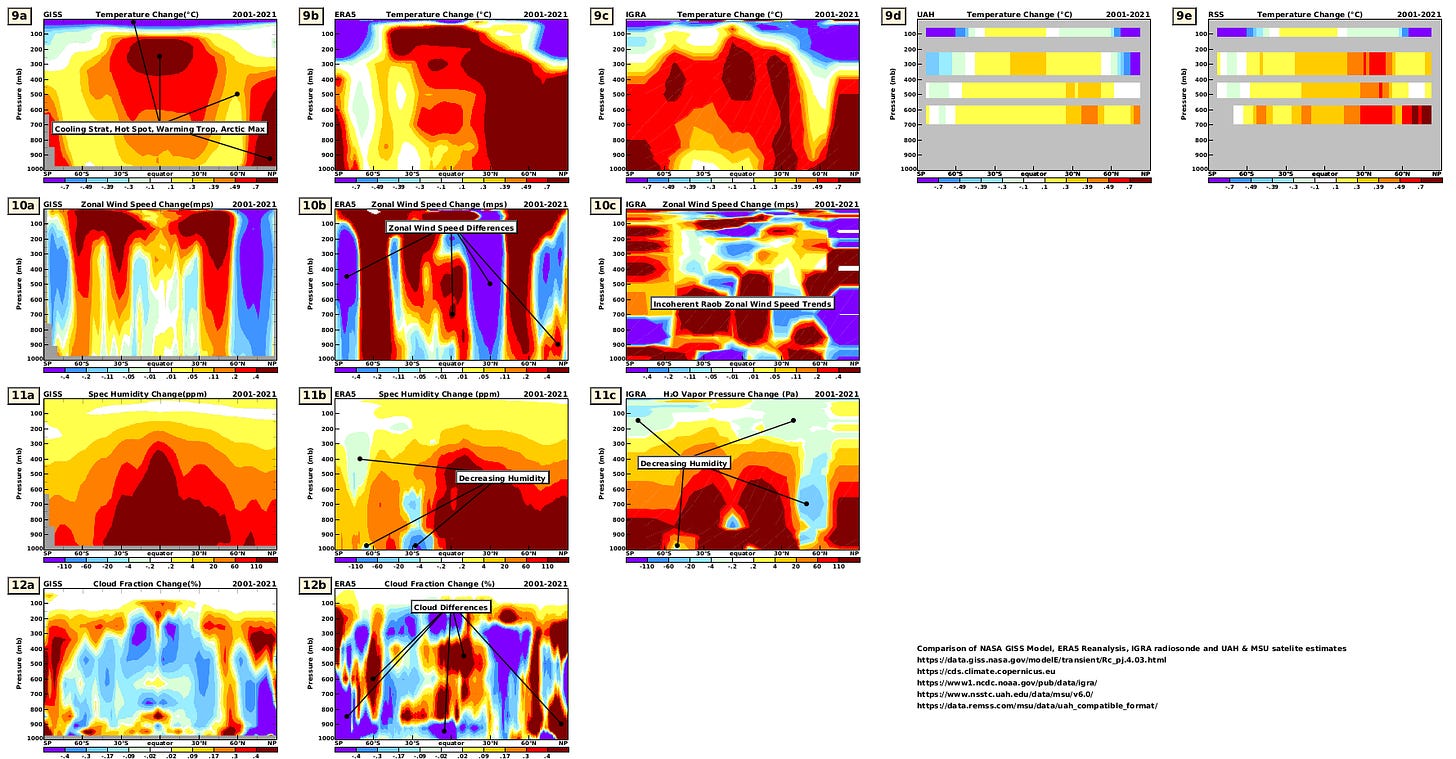The following is an update of Vertical Profiles of Climate Change. As described in that posting, the analyses compare vertical profiles of climate model predictions from past NASA GISS Model E runs with the profiles of the ECMWF ReAnalysis (ERA5), of the Integrated Global Radiosonde Archive (IGRA) V2 data set, and of the Remote Sensing Systems (RSS) and the University of Alabama at Huntsville (UAH) satellite based Microwave Sounding Unit (MSU) data. The analyses are for the RAOB Era ( 1958 through 2021 ), the MSU Era ( 1979 through 2021 ) and the Twenty-First Century ( 2001 through 2021 ).
Vertical Profiles of RAOB Era Climate Changes

Vertical Profiles of MSU Era Climate Changes

Vertical Profiles of Twenty-First Century Climate Changes

Discussion
The trends of this update, being extended by only a single year, differ only slightly from those through 2020, but the updated trends exhibit the following qualitative characteristics.
Temperature. Broadly, observations and reanalyses tend to support the modeled predictions of decreasing stratospheric temperature, increasing tropospheric temperature, and an Arctic maxima of temperature increase for each of the defined periods of interest. The Hot Spot is not well supported over the RAOB and MSU eras but is suggested over the still brief Twenty-First Century period by the Reanalysis and RAOB data.
Zonal Wind Speed. The mid-latitude upper “t-bone” shaped maxima appear in the reanalysis for all three periods. There are qualitative contradictions of zonal wind speed between model and reanalysis elsewhere. The RAOB data appear to lack coherent trends.
Humidity. The Reanalysis and RAOB trends for all three periods indicate areas of relatively intense decreases of absolute humidity which conflict with modeled trends.
Cloud Fraction. Reanalysis cloud fraction trends are in qualitative disagreement with modeled cloud fraction trends for large portions of the global vertical profile for all three periods.
There are uncertainties with the reanalyses, raob averages and satellite based data. Among other things, spatial and temporal coverage are sparse, instrumentation and calibrations change over time with observations. And the reanalysis process involves a degree of prognostication, extrapolation, and use of similar parameterizations as those in the climate models against which we compare results.
References
Syukuro Manabe (2019), "Role of greenhouse gas in climate change", Tellus A: Dynamic Meteorology and Oceanography, 71:1, https://doi.org/10.1080/16000870.2019.1620078
J. Hansen, M. Sato, R. Ruedy, P. Kharecha, A. Lacis, R. Miller, L. Nazarenko, K. Lo, G. A. Schmidt, G. Russell, I. Aleinov, S. Bauer, E. Baum, B. Cairns, V. Canuto, M. Chandler, Y. Cheng, A. Cohen, A. Del Genio, G. Faluvegi, E. Fleming, A. Friend, T. Hall, C. Jackman, J. Jonas, M. Kelley, N. Y. Kiang, D. Koch, G. Labow, J. Lerner, S. Menon, T. Novakov, V. Oinas, Ja. Perlwitz, Ju. Perlwitz, D. Rind, A. Romanou, R. Schmunk, D. Shindell, P. Stone, S. Sun, D. Streets, N. Tausnev, D. Thresher, N. Unger, M. Yao, and S. Zhang, "Dangerous human-made interference with climate: A GISS modelE study", Atmos. Chem. Phys. 7,9 (07 May 2007): 2287-2312 https://doi.org/10.5194/acp-7-2287-2007
Hersbach, Hans & Bell, Bill & Berrisford, Paul & Hirahara, Shoji & Horányi, András & Muñoz Sabater, Joaquín & Nicolas, Julien & Peubey, Carole & Radu, Raluca & Schepers, Dinand & Simmons, Adrian & Soci, Cornel & Abdalla, Saleh & Abellan, Xavier & Balsamo, Gianpaolo & Bechtold, Peter & Biavati, Gionata & Bidlot, Jean & Bonavita, Massimo & Thépaut, J.-N. (2020). The ERA5 global reanalysis. Quarterly Journal of the Royal Meteorological Society. https://doi.org/10.1002/qj.3803.
Copernicus Climate Change Service (C3S) (2017): ERA5: Fifth generation of ECMWF atmospheric reanalyses of the global climate, Copernicus Climate Change Service Climate Data Store (CDS), accessed January 8, 2022, https://cds.climate.copernicus.eu/cdsapp#!/home.
Imke Durre, National Centers for Environmental Information (NCEI), Integrated Global Radiosonde Archive V2, https://www1.ncdc.noaa.gov/pub/data/igra/igra2-dataset-description.docx. Data accessed Jan 14, 2022, https://www1.ncdc.noaa.gov/pub/data/igra/monthly/monthly-por/.
Roy Spencer, John Christy, and William Braswell, "UAH Version 6 global satellite temperature products: Methodology and results," Asia-Pacific J Atmos Sci 53, 1, (February 2017): 121-130, doi:10.1007/s13143-017-0010-y.
UAH MSU data accessed January 8, 2022 from: https://www.nsstc.uah.edu/data/msu/v6.0/.
Carl A. Mears and Frank J. Wentz, "A Satellite-Derived Lower-Tropospheric Atmospheric Temperature Dataset Using an Optimized Adjustment for Diurnal Effects," J. Climate 30, 19 (October 1, 2017): 7695-7718, doi:10.1175/JCLI-D-16-0768.1.
RSS MSU data accessed January 8, 2022 from: http://data.remss.com/msu/data/uah_compatible_format/.



